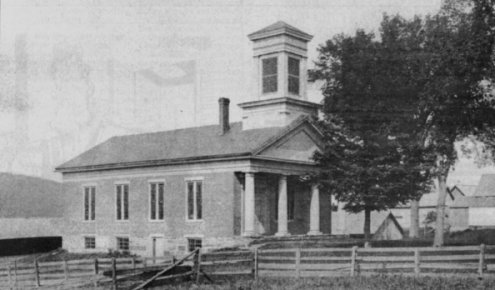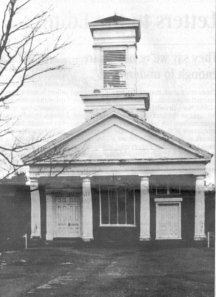
The Baptist Building in Fairfax as it appeared in 1892
photo courtesy Fairfax Historical Society
THE BAPTIST BUILDING OF FAIRFAX

The Baptist Building in Fairfax as it appeared in 1892
photo courtesy Fairfax Historical Society

The Baptist Building in its current state - April, 2000
by Sally(Wilkins) Sweet and Rev. Elizabeth Griffin
as published in The St. Albans (Vt.) Messenger
Saturday, April 29, 2000
It had to do with stones. Suitable stones had to be found for the basement or the building couldn't be built. For Elder Lewis Dunn-who is, by the way; buried in the Sanderson's Corner's Cemetery in Fairfax-finding the stone and building the church edifice would determine whether or not he continued the ministry he had begun in Fairfax in 1843. And so, one day; in one last effort, Elder Dunn and Ozias Story; a local mason, went in search of the right stone. The two men went to test the ledge, and Dunn went and sat a short distance away; head in hands, while Story tested the rock. According to Judge Fairman in the "Centennial History of the First Baptist Church," Dunn's "sorrow is turned to joy;" as he heard the rock break. Now he could stay in Fairfax and continue his ministry; Thus, in 1848 the First Baptist Church in Fairfax was built on the crest of the hill that descends into the village, and the ministry which was organized in 1792 with 25 members who worshipped in a log cabin on what is now Buck Hollow Road, continued in the elegant brick edifice which still stands on that hill overlooking the village. Like most Vermont churches the history of the First Baptist Church of Fairfax now sounds quaint and charmingly old-fashioned; it makes one wonder about what life might have been like for a pastor in the 19th century. The first Baptist pastor, probably in the early 1800's, one Mr. Andrews was ordained while kneeling on a rock! His pay for the year included board and clothing for himself and his wife and $5 for books.
A little later, in January of 1806, the members of the church voted to call Rev. Amos Tuttle to be pastor. He was given a lot of land worth $400 as settlement. A subscription was called to raise this money; and if that was unsuccessful, the money was to be raised on the polls and estate of the Baptist Society: A committee was formed to resolve this, and church members agreed to pay his salary of $200 in the following way: $20 of pork $15 of beef; $5 of tallow, $15 of rye, $10 of wool, $25 of wheat, and $10 of flax. The balance was to be paid in articles most convenient to the church. One wonders exactly what those articles were. Controversy of various sorts beset the early church. As was typical of those times, members who did not follow the precepts of the church were "disciplined." When the church decided to pay the minister's salary by a tax on the estimated property of the members, Deacon Wilkins stopped communing in protest. When controversy over the baptism of members by those who were not ordained Baptist ministers arose, it was voted that only Baptism by a Baptist minister was valid. Those who disagreed with this decision were "admonished" and as a result the minister, Rev. Amos Tuttle, the current church officers and 33 members were excluded from the fellowship. This dark time in the history of the church was lightened when the Baptist and the Congregationalist churches of Fairfax agreed to build a meeting house for shared worship. In 1824 the Baptists and Congregationalists built the first meeting house in Fairfax. The two groups alternated weekly services there. Located across the street from the present Baptist Building, it later became apart of the New Hampton Institute. The growth of the Baptist fellowship prompted the construction of the current Baptist Church--now called the Baptist Building--in 1848.
The church was dedicated in 1849, and the congregation grew so rapidly that in 1851 there was a need for more worship space; the church was enlarged by dividing it near the center of the building, and moving the rear part of the church back sixteen feet. Between the dedication of the church and the turn of the century the church grew and prospered. A choir was begun in 1868; in 1869 coal and wood were used to heat the building. In the 1880's the congregation determined that remodeling was needed and money was raised by subscription. The Ladies of the Church, an organization that is still going strong, was responsible for purchasing carpets for the church. In 1875 the church purchased the house on the north side of the church as a parsonage. This house is now a private dwelling. Although the 20th century brought new sidewalks, town water and town sewer, it also brought the depression. Because of the financial difficulties the church faced, it united with the Methodist Church of Fairfax to form the United Church of Fairfax. The union has worked well. Worship services are held in the Methodist Church building and social events are held in the Baptist Building. In order to maintain its status as a church building, the congregation of the United Church worships at the Baptist Building during July.
Since 1939 when the two denominations merged, the building, though no longer used for weekly church services, has served the community in a variety of ways. When the Fairfax school burned in 1941 it provided classroom space. The Fairfax Fire Department held its Annual Lawn Party on the sloping lawns of the building. The Fairfax Historical Society holds its Annual Ice Cream and Pie Social there, and the Fairfax Fletcher Westford Band provides the entertainment. Many other groups and individuals use the building for various functions.
When, in 1967 the United Church of Fairfax found it increasingly difficult to maintain both churches, the Lamoille Lodge No.6, F&AM and Fairfax Unity Chapter No. 17, O.E.S. was also in need of a meeting place, The church entered into a 25-year lease with these groups, and the Lodge assumed responsibility for overseeing and maintaining the property.
The building has served the community since 1848. Many residents and their ancestors have been baptized, educated, married, entertained, and eulogized in The Baptist Building. The Boy and Girl Scouts, Retired Teachers Association, Alpha Delta Gamma, and Fairfax Historical Society hold meetings here. An Easter Egg Hunt is held each year for town youth by the Fairfax Unity Chapter No.17" O.E.S. The Christmas boxes for the senior citizens and the needy of the community were packed and distributed from the Baptist Building this past year. The annual Bean Hole Supper attracts well over 400 people who come to enjoy the food and be entertained by the Green Mountain Banjos.
Today; our Historic Building, which is on the State of Vermont Register of Historic Places, is again in need of repair. The Lamoille Lodge No. 6 F&AM with the help of the Fairfax Unity Chapter No.17, O.E.S. is leading the efforts to restore the Baptist Building. Fundraising efforts to date have included deer hunters' breakfasts, quilt and 50/50 raffles, a soup and salad luncheon and garden tour. The group has received a matching grant of $5000 from the Vermont Division of Historic Preservation, and a $20,000 grant from the Preservation Trust of Vermont, which is funded by the Freeman Foundation. Our budget is $109,639. A Capital Campaign Drive will begin May 1. Anyone wishing to donate to the restoration of this 152-year old Greek Revival building may do so by mailing their tax exempt donation to: Lamoille Lodge Building Fund, c/o Wayne Sweet, treasurer, 44 Sweet-Slattery Road, East Fairfield, VT 05448. All donations of $175 or more will receive a commemorative gift as a thank you.